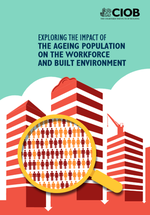Exploring the impact of the ageing population on the workforce and built environment
On 10th December 2015 the Chartered Institute of Building (CIOB) published: Exploring the impact of the ageing population on the workforce and built environment.
The percentage of people in the world aged 60 or over has increased from 9.2% in 1990 to 11.7% in 2013 and is forecast to reach 21.1% by 2050.
The CIOB report explores the effects of this ageing population on the construction industry and how the sector can adapt to meet some of the challenges it poses. It comes six years after a previous CIOB study which highlighted the crucial role the of built environment in improving the lives of older people.
The report is based on a survey of nearly 1,000 CIOB members. Its findings include:
- The built environment has a crucial role to play in terms of improving the lives of older people. However, awareness of the ageing population and its influence on the built environment has decreased since the previous report, despite changes in legislation.
- 19% of the construction workforce is set to retire in the next five to ten years. To be successful, construction needs greater investment to retain ageing workers’ knowledge and skills, where necessary, re-purposing job descriptions and overcoming stereotypes.
- 57% of respondents acknowledged it is ‘very important’ to retain ageing workers, but few adopt measures such as flexible working, succession planning, mid-life career reviews or retirement planning.
- More needs to be done to make use of ageing workers’ expertise and skills. Only 63% of respondents use mentoring as a regular feature in the workplace.
- Trade roles can give potential recruits the impression that the industry is dirty and dangerous.
It concludes that there is an increasing need to view the ageing population positively, utilising the ageing workforce better and redefining buildings.
Deputy Chief Executive of the CIOB Bridget Bartlett said: “… if construction is to meet the skills crisis it faces and fill the 224,000 vacancies needed by 2019, employers should look to take additional steps to overcome the skills shortages they incur by reaching out to older workers. There is a huge opportunity to showcase to both young and old members of the workforce that construction isn’t all hard hats and hi-vis and that off-site opportunities are aplenty. We demand technical skills as much as manual skills.
“Employers must also recognise the skills of their existing workers and put in measures such as flexible working, career reviews or even retirement planning to encourage longer working lives. As our own research tells us, skills shortages in construction are compounded by those entering the industry not being suitably qualified for the position. We should take this opportunity to use older workers to tap into their skills and knowledge and ensure they are passed onto the next generation.”
--CIOB
[edit] Related articles on Designing Buildings
- Accessibility in the built environment.
- Age diversity for social cohesion.
- Apprenticeships levy.
- Changing lifestyles.
- Construction skills shortage still stifling growth.
- Gangmaster.
- Inclusive design.
- Lifetime homes.
- Lifetime neighbourhoods.
- National Infrastructure Plan for Skills.
- Online mentoring can help professionals succeed.
- Perkins review.
- Protection for apprenticeships.
- Skills to build.
- Tackling the construction skills shortage.
Featured articles and news
Government consultations for the summer of 2025
A year of Labour, past and present consultations on the environment, the built environment, training and tax.
CMA competitiveness probe of major housing developers
100 million affordable housing contributions committed with further consultation published.
Homes England supports Greencore Homes
42 new build affordable sustainable homes in Oxfordshire.
Zero carbon social housing: unlocking brownfield potential
Seven ZEDpod strategies for brownfield housing success.
CIOB report; a blueprint for SDGs and the built environment
Pairing the Sustainable Development Goals with projects.
Types, tests, standards and fires relating to external cladding
Brief descriptions with an extensive list of fires for review.
Latest Build UK Building Safety Regime explainer published
Key elements in one short, now updated document.
UKGBC launch the UK Climate Resilience Roadmap
First guidance of its kind on direct climate impacts for the built environment and how it can adapt.
CLC Health, Safety and Wellbeing Strategy 2025
Launched by the Minister for Industry to look at fatalities on site, improving mental health and other issues.
One of the most impressive Victorian architects. Book review.
Common Assessment Standard now with building safety
New CAS update now includes mandatory building safety questions.
RTPI leader to become new CIOB Chief Executive Officer
Dr Victoria Hills MRTPI, FICE to take over after Caroline Gumble’s departure.
Social and affordable housing, a long term plan for delivery
The “Delivering a Decade of Renewal for Social and Affordable Housing” strategy sets out future path.
A change to adoptive architecture
Effects of global weather warming on architectural detailing, material choice and human interaction.
The proposed publicly owned and backed subsidiary of Homes England, to facilitate new homes.
How big is the problem and what can we do to mitigate the effects?
Overheating guidance and tools for building designers
A number of cool guides to help with the heat.
The UK's Modern Industrial Strategy: A 10 year plan
Previous consultation criticism, current key elements and general support with some persisting reservations.
Building Safety Regulator reforms
New roles, new staff and a new fast track service pave the way for a single construction regulator.


























